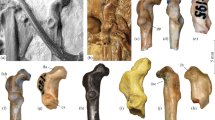Abstract
Tynskya eocaena n. gen. n. sp. is described from Lower Eocene deposits of the Green River Formation (Wyoming, USA). The species is characterized by a distinctive morphology of the tarsometatarsus. AlthoughTynskya eocaena resembles the Lower and Middle Eocene PseudasturidaeMayr 1998 and some recent strigiform and falconiform birds in several aspects, it has not been possible to find derived characters which convincingly support a classification of this species into one of the known higher avian taxa. Birds closely related toTynskya eocaena have also been found in the Lower Eocene London Clay of Walton-on-the-Naze (Essex, England) and give a further example of the great similarity between the early Eocene avifauna of North America and Europe.
Kurzfassung
Tynskya eocaena n. gen. n. sp. wird aus untereozänen Ablagerungen der Green River Formation (Wyoming, USA) beschrieben. Die Art ist durch einen kennzeichnenden Bau des Tarsometatarsus charakterisiert. ObwohlTynskya eocaena den unter- und mitteleozänen PseudasturidaeMayr 1998 und einigen rezenten strigiformen und falconiformen Vögeln hinsichtlich verschiedener Merkmale ähnelt, konnten keine abgeleiteten Merkmale gefunden werden, die eine Klassifikation dieser Art in eines der bekannten höheren Vogel-Taxa überzeugend unterstützen. MitTynskya eocaena nahe verwandte Vögel wurden auch im unterem Eozän des London Clay von Walton-on-the-Naze (Essex, England) gefunden und geben ein weiteres Beispiel für die große Übereinstimmung zwischen der frühtertiären Avifauna von Nordamerika und Europa.
Similar content being viewed by others
References
Baumel, J. J. &Witmer, L. M. (1993): Osteologia. — In: J. J.Baumel, A. S.King, J. E.Breazile, H. E.Evans & J. C.Vanden Berge [Eds], Handbook of avian anatomy: Nomina Anatomica Avium. — Publications of the Nuttall Ornithological Club,23: 45–132, 18 text-figs; Cambridge/Mass.
Cracraft, J. (1981): Toward a phylogenetic classification of the recent birds of the world (Class Aves). — Auk,98: 681–714; Washington/D.C.
Cracraft, J. (1988): The major clades of birds. — In:M. J. Benton [Ed.], The Phylogeny and Classification of the Tetrapods, Vol. 1: Amphibians, Reptiles, Birds: 339–361, 1 text-fig.; Oxford (Clarendon Press).
Feduccia, A. (1996): The Origin and Evolution of birds. — 1–420, many text-figs and tabs; New Haven, London (Yale University Press).
Harrison, C. J. O. (1982): A new tiny raptor from the Lower Eocene of England. — Ardea,70: 77–80, 2 text-figs; Leiden.
Harrison, C. J. O. (1984): Further additions to the fossil birds of Sheppey: A new Falconid and three small Rails. — Tertiary Research,5 (4): 179–187, 4 text-figs; Leiden.
Harrison, C. J. O. &Walker, C. A. (1979): Birds of the British Middle Eocene. — Tertiary Research, Special Paper,5: 19–27, 1 pl.; Rotterdam.
Houde, P. (1988): Palaeognathous birds from the early Tertiary of the Northern Hemisphere. — Publications of the Nuttall Ornithological Club,22: 1–148, 41 text-figs, 27 tabs; Cambridge/Mass.
Martin, L. D. &Black, C. C. (1972): A New Owl from the Eocene of Wyoming. — Auk,89 (4): 887–888, 1 text-fig.; Washington/D.C.
Mayr, G. (1998): A new family of Eocene zygodactyl birds. — Senckenbergiana lethaea,78 (1/2): 199–209, 12 text-figs, 3 tabs; Frankfurt am Main.
Mayr, G. &Peters, D. S. (1998): The mousebirds (Aves: Coliiformes) from the Middle Eocene of Grube Messel (Hessen, Germany). — Senckenbergiana lethaea,78 (1/2): 179–197, 5 text-figs, 9 tabs, 4 pls; Frankfurt am Main.
Mourer-Chauviré, C. (1994): A large owl from the Palaeocene of France. — Palaeontology,37 (2): 339–348, 2 text-figs, 2 tabs, 1 pl.; London.
Rich, P. V. &Bohaska, D. J. (1976): The World’s Oldest Owl: A New Strigiform from the Paleocene of Southwestern Colorado. — Smithsonian Contributions to Paleobiology,27: 87–93, 3 text-figs, 1 pl.; Washington/D.C.
Steinbacher, G. (1935): Funktionell-anatomische Untersuchungen an Vogelfüßen mit Wendezehen und Rückzehen. — Journal of Ornithology,83 (2): 214–282, 33 text-figs; Berlin.
Stephan, B. (1992): Vorkommen und Ausbildung der Fingerkrallen bei rezenten Vögeln. — Journal of Ornithology,133 (3): 251–277, 1 text-fig., 12 tabs; Berlin.
Wetmore, A. (1938): Another Fossil Owl from the Eocene of Wyoming. — Proceedings of the United States National Museum,85 (3031): 27–29, 2 text-figs; Washington/D.C.
Author information
Authors and Affiliations
Rights and permissions
About this article
Cite this article
Mayr, G. A new raptor-like bird from the Lower Eocene of North America and Europe. Senckenbergiana lethaea 80, 59–65 (2000). https://doi.org/10.1007/BF03043664
Received:
Accepted:
Issue Date:
DOI: https://doi.org/10.1007/BF03043664




